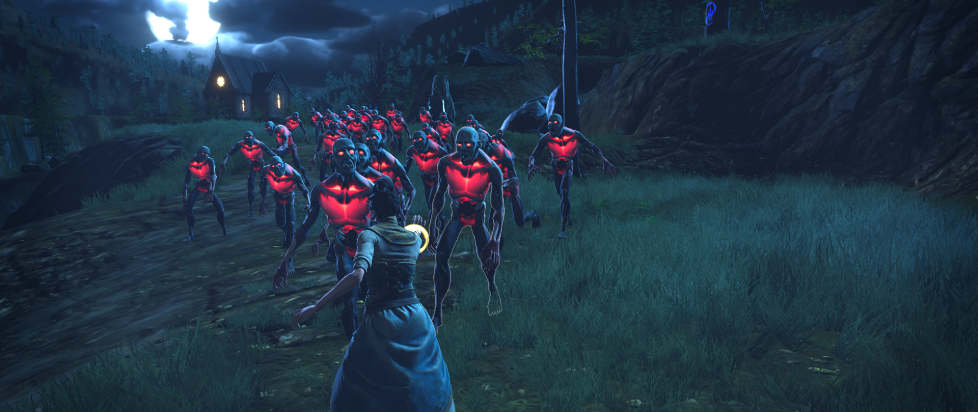
Melting Time With Autoexec Games
If there’s one thing that games have struggled with over the years, it’s time travel. While several have tinkered with letting players disrupt the flow of time, none before have been so bold as Autoexec Games to let players melt time itself. Designed by the co-creator of the equally unconventional Sang-Froid: Tales of Werewolves, TimeMelters’ surprising blend of strategy, action, and time loops was born, of all things, during “a ghost tour in Scotland!” explains Autoexec’s Adam Rotondo.
“You can take these really interesting guided tours in these really old cities and they tell you all about the different witches and ghosts that haunt the lands. After hearing some of these stories, we did some research and learned about all kinds of witch hunts that took place in North Berwick during the 16th century. We thought a game where you play a witch hunted by the kingsmen would be awesome.” Though TimeMelters would grow in scope to see players fighting all manner of blighted creatures, it still opens with a harrowing escape from a witch trial that nearly sees its heroine burned by a mob.
Drawing from real-world folklore is a key inspiration for the team, as Rotondo elaborates, “We always try to take a lot of inspiration from history. There’s a lot of good stuff there if you take the time to look.” The key twist being: “What would you do if the world was already doomed! Since TimeMelters is all about time travel, we not only play around with it in the gameplay but with the story as well. Characters die and towns get burned down, but it’s all ok, because you can just fix it in the next timeline.” It’s quite the ambitious undertaking for the three-person team.
While serving directly as the team’s Community Manager, Rotondo describes a highly collaborative, jovial effort behind the scenes: “We’re all friends – a programmer, an animator and a jack of all trades! And we all used to work together at various studios over the years before coming together to found Autoexec Games.” The team of friends also made a point of emphasizing gameplay “over AAA graphics”, as is proudly displayed on the game’s store page. Given that, I had to ask the obvious – how would Autoexec make time manipulation work? What was the key stumbling block for so many studios?

As Rotondo puts it, “Good level design! There are so many moving pieces in TimeMelters, it can be very hard to keep track of what’s going on as a player. We tested and reworked levels for months until we felt like we nailed it properly.” Rather than simply letting players reverse time, TimeMelters throws in the wrinkle of leaving echoes of your past timelines, following your exact movements until time was reversed, creating a veritable squad of yourselves. “One of the most fun things we’ve found is just watching your echos do their handy work. You get to bask in your strategy until it’s time to strike in your current timeline.”
Getting TimeMelters to that point was hard work though, with numerous iterative steps taken over the course of the game’s Steam Early Access period. “The hardest part was definitely relaying the appropriate information back to the player. We spent a lot of time working on our UI and feedback recognition. You have to know which groups die and when; which echoes did the killing; what spells are cast at any given moment. Keeping track of all of this information is instrumental in planning a winning strategy.” Though while honing the game pre-Early access, they did come up against an unexpected hurdle: “You eventually get so good at your own game, it can be hard to gauge just how tough anything really is. We originally only had 1 difficulty setting, and the game was REALLY tough. I’d say the strategist’s difficulty in-game right now is in line with how hard it was,” Rotondo says with a chuckle. “Fortunately, Early Access was a godsend for us, since we were able to gather feedback from new players. Having access to this passionate group of players was a massive help for us. Watching streamers interact with the game was also a huge help. Being able to see someone with your game in their hands is the best information for a game developer.
We quickly decided to add our own analytics directly into the game so we could see how players were interacting with it.” A key part of the game’s evolution would turn out to be its tutorial level, apparently calling for “multiple” adjustments to ensure “the best first user experience.”.
Achieving that delicate balance with time travel led to all manner of surprising design solutions, like keeping players from being too risky by giving them a single hitpoint. Except, “Whenever the player gets hit, they go back in time, so it’s as if they have more than one health. The player only really dies when they run out of Time Mana.” Yet it still ensures that players make every life count, “making good use of each echo.”

To further ease players in, you’re also able to spawn a one-time teleport to get you out of harm’s way without a rewind. Rotondo credits player feedback for helping the team craft several key additions: “Multiple difficulties, updated challenges, and even added a speedrun mode. The game would not be what it is today without our Early Access players, and we’re truly grateful for everyone’s help!”
Rotondo regularly cites risk and reward driving their design ethos, elaborating “Resource management is a big part of RTS games and it plays a huge role in TimeMelters since the mana you absorb on any given map is finite. Figuring out how to capture the mana, where best to use it, managing your echoes and all the enemies can take some serious brain power, like any challenging strategy game.”
It’s something echoed by their players. As Rotondo puts it, “Our players really love overcoming challenges. Forming a great strategy, incorporating all your echoes, slowly watching it come together. It’s been incredible to see people play. I don’t think there’s a better feeling as a game dev.”
And while TimeMelters is real-time, “We love strategy games of all kinds,” Rotondo says with a grin, “be it MOBA, RTS, turn-based, or tower defense. So we tried to mix and match different elements from each into our levels; no two levels feel alike. Things like wave management, allies and aggro can work very well in a single player or co-op game, but it also helps that we can use our echoes as a sort of solo-multiplayer.”
Even though it was designed with solo play in mind, the appeal of co-op was undeniable to the Autoexec team. “Everything is more fun with a friend, need we say more?” Yet by the same turn, adding multiplayer “easily doubled the workload on all fronts.” From rebalancing to altering key missions to remain unique on a second playthrough in co-op, the whole experience truly does sound akin to creating an entire bonus game. “We would love to add co-op challenges in the future if time permits,” Rotondo, “But right now, everyone can look forward to an expanded list of speedrun maps!” Autoexec’s ambitions continue to run at full steam. When asked about the future, Rotondo proudly declares, “The console release! We’re really looking forward to that this summer!
TimeMelters is available now on Steam.
———
With over ten of writing years in the industry, Elijah’s your guy for all things strange, obscure, and spooky in gaming. When not writing articles here or elsewhere, he’s tinkering away at indie games and fiction of his own.





